|

Very Effective
Igor Stravinsky's 'The Soldier's Tale'
at the Presteigne Festival,
reviewed by KEITH BRAMICH
More or less the only negative thing I can say about the 2016 Presteigne Festival's first evening performance last night (Thursday 25 August 2016 at St Andrew's Church, Presteigne, Powys, UK) concerns the lashings of heavy rain, dull grey sky and high humidity, but not even the weather could put off the capacity audience attending this music theatre event on the edge of the Welsh border marches.
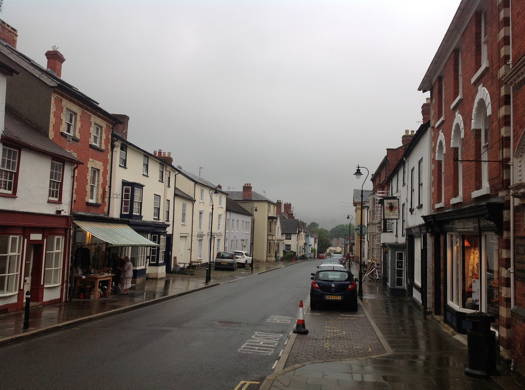
Dull, rainy weather in Presteigne, Powys on 25 August 2016. Photo © 2016 Keith Bramich
|
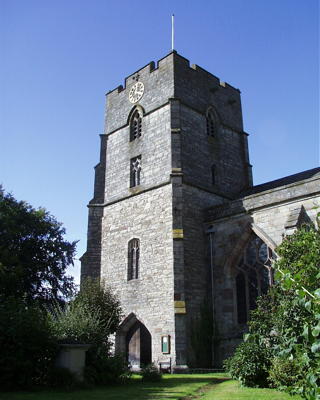
St Andrew's Church, Presteigne, with more typical festival weather, in August 1998. The forecast for most of the rest of the festival indicates much brighter weather than yesterday's. Photo © 1998 Keith Bramich
|
As iconic as Walton's Façade or Schoenberg's Pierrot Lunaire from the same period, Igor Stravinsky's jazzy, spiky and tonally ambiguous 1918 score for L'histoire du soldat addresses fundamental philosophical issues concerning opposites in life, such as good/evil, having/not having, movement/stasis, wealth/poverty and past/future. The original French libretto for this strikingly Faustian Russian folk tale The Runaway Soldier and the Devil, collected by Alexander Afanasyev, was translated and prepared by the composer with Swiss writer Charles-Ferdinand Ramuz.
Michael Flanders and Kitty Black's English translation is used in JoAnn Falletta's recent Naxos audio recording, also reviewed in today's M&V, but the visual side of this work adds an extra dimension, so that unlike Gerald Fenech, who found that 'staying focused on the unfolding twists of the story for nearly an hour is an arduous task', I found that time passed quickly in this compelling Presteigne Festival production (in association with the Dartington International Summer School and Festival).
Director Richard Williams has adapted the Flanders/Black translation, and has also added the twist of casting the devil as a woman. During an illuminating thirty-minute pre-concert conversation with composer Thomas Hyde, Williams (careful to refer to the devil as 'it', but explaining that traditional Christian iconography depicts 'it' as male) explained much of the rationale behind his production. 'Have you tried to make it look cheap for artistic reasons?', Hyde asked. 'Money affects things, and makes a difference to how you think about things', Williams explained, referring to the 'back-of-a-lorry' production that Stravinsky envisaged whilst cut off in Switzerland during World War I, and how things changed when the first performance, after the armistice in 1918, became a fashionable event supported by an exiled grand duchess.
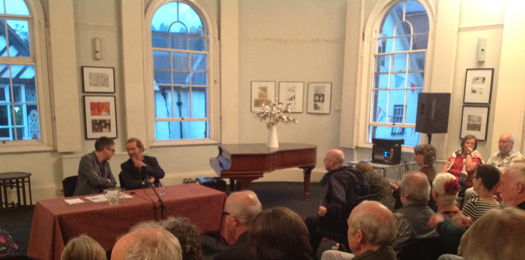
Composer Thomas Hyde (left) in discussion with opera director Richard Williams about Stravinsky's 'The Soldier's Tale' in the Assembly Rooms, Presteigne. Photo © 2016 Keith Bramich
|
The Soldier's Tale uses actors rather than singers, and there was some fascinating discussion between Williams and Hyde, suggesting that actors, who often begin their careers later in life, may have a better sense of long-term rhythm than musicians, but in other ways are much less disciplined, often taking a month of rehearsals to put together what would take musicians (albeit with music scores in front of them) just three hours.
Triggered by Hyde's question 'What is the music doing?', Williams was able to explain how, in the first part of the work, the music reflects rather than commenting on the action, that the action slows and often stops whilst the music is playing, and that the music indicates forwards and backwards motion in time, giving a sense of the action being repeated. Later, in the second part, music and action become more closely integrated.
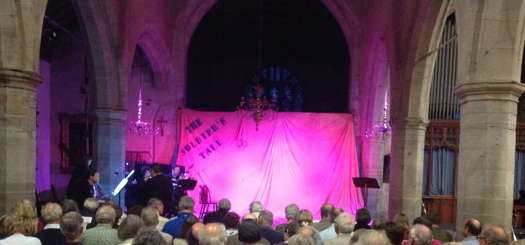
Members of Nova Music Ensemble tuning up before the performance of Stravinsky's 'The Soldier's Tale' at the 2016 Presteigne Festival. Photo © 2016 Keith Bramich
|
Williams, with his musical collaborator, festival director and conductor George Vass, are both keen to provide opportunities for young performers. Here, using a simple setting in quite a small performing area were, stage-right, the very able septet of musicians forming the Nova Music Ensemble, successfully navigating their way around Stravinsky's score. There were four actors — Paul Ryan, the narrator, stood stage-left in front of a music stand, but was often drawn into the plot to take on other, secondary roles. Then (mostly centre-stage, but at one point walking around the church amongst the audience) there were Wayne Wilson as the gullible violin-playing soldier and Chloe Astleford as an alluring and very female devil, whose rapid changes of costume and accent must have kept her busy. Near the end of the work, (non-speaking) dancer Rosie Hancock makes her appearance as the princess.
Providing yet another dimension was Translight (Graham George and Keith Hatfield), lighting the stage in alternate orange (for the recurring soldier's march) and blue for much of Part I, reinforcing the music's timescale changes, then becoming more adventurous in Part II — bright red for the devil, back-lit from high above the stage for part of the soldier's very effective dance sequence with the princess, later also using green light, then fading to darkness as the music dies away to quiet drums at the end.
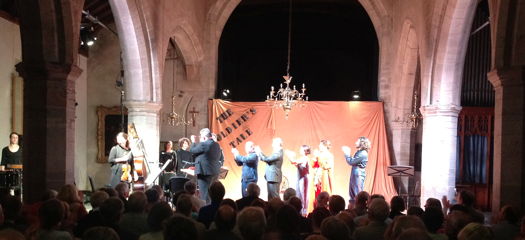
The conductor, producer and actors acknowledge the musicians at the end of Stravinsky's 'The Soldier's Tale' at the 2016 Presteigne Festival. Photo © 2016 Keith Bramich
|
A friend in the audience thought that the stage could have been higher, as he found it difficult to see all the action, and I realised that I too had been straining upwards at times to see over people's heads. Festival founder Adrian Williams, sitting nearby, whose new commission Cadenzas, Scherzos and Cantilenas gets its first performance on Monday, honouring the composer and former artistic director's sixtieth birthday this year, quickly summarised the evening: 'Stravinsky's marching soldier stole the stage in what became a dramatically slick production by Nova Music Opera, including a virtuoso instrumental team fresh from Dartington under the baton of George Vass. I mused upon how, in the early founding years of 1982/3, we almost did not dare dream of such peaks of excellence in Presteigne. The thirty-fourth festival is rolling forward.' Other works by Adrian in this festival include Knocknarea for solo harp (Elizabeth Scorah, Saturday, 11.30am), St Chad's Mass (Festival Eucharist, Sunday, 11am), The Ways of Going — a cantata after Alun Lewis (Damian Thantrey, baritone, Emily Pailthorpe, oboe and the Carducci Quartet, Sunday 3pm) and Elegy (Sunday, 7.45pm, Presteigne Festival Orchestra conducted by George Vass).
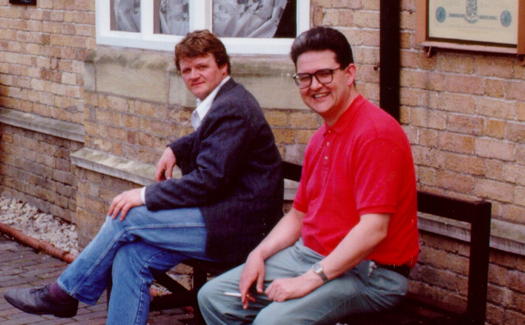
Adrian Williams (left) and George Vass in 1989. Photo © 1989 Keith Bramich
|
Comparing last night's experience with various visits at the end of the 1980s, I couldn't help but notice how much more professional this festival now seems than when Adrian Williams and I once had to run through the rain, carrying cider crates into one of the concert venues to make an improvised conductor's podium, just minutes before the start of a choral concert! Last night, in contrast, I particularly noticed the relaxed atmosphere, the professionalism of the support staff, the increased quantity and variety of advertising in the programme booklet, and the change in programming, with many more twentieth century and contemporary works than previously. At a reception held before last night's concert, George Vass, currently chair of the British Arts Festivals Association, commented on how valuable his own festival's generous funding from Powys County Council has been, at a time when various festivals across the border in England have been forced to chase project-based funding.
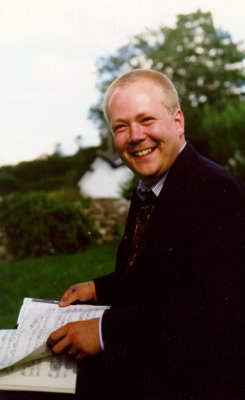
Philip Sunderland, an old friend of the Presteigne Festival, who takes up a new appointment in September 2016 as head of Vocal Faculty Opera at the Royal Academy of Music in London, conducts the Presteigne Festival Chamber Choir on Saturday 27 August 2016 in music by Richard Rodney Bennett, Thomas Hyde, William Walton, Deborah Pritchard and Cecilia McDowall. Photo © 1997 Keith Bramich
|
Presteigne's six-day festival continues until Tuesday 30 August 2016. This afternoon, Clare Hammond's piano recital (2pm, Friday 26 August 2016, again in St Andrew's Church) includes more Stravinsky (three movements from Petrouchka), Au gré des ondes by Henri Dutilleux, and features the first performance of a Presteigne Festival commission — Haiku, by the festival's president, Michael Berkeley, plus the first complete performance of Robert Saxton's Hortus Musicae Book II (as mentioned here recently by Mike Wheeler).
Robert Saxton is the Presteigne Festival's composer in residence this year. A bit later this afternoon, festivalgoers can hear him in conversation with Thomas Hyde (a former pupil) about his life, obsessions, passions, hates and favourite music. Throughout the weekend there are performances of other Saxton works — Shakespeare Scenes, the Sonata for Solo Cello on a Theme of Sir William Walton (played by Presteigne regular Alice Neary), Fantazia, Arias, Chacony and Time and the Seasons, culminating in the first performance of a Presteigne Festival commission — The Resurrection of the Soldiers — which begins the Festival Finale concert on Tuesday evening (30 August 2016).
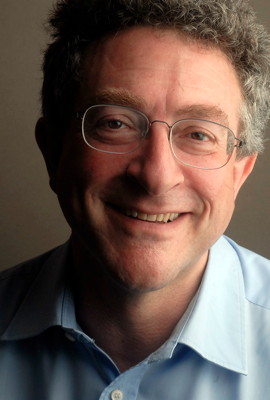
Robert Saxton. Photo © Katie Vandyck
|
Other first performances over the bank holiday weekend include The Heavens and The Heart — three psalms for chorus and small orchestra by James Francis Brown (Sunday, 7.45pm, Presteigne Festival Chamber Choir, Presteigne Festival Orchestra and George Vass), and Raven's Cage by Ninfea Cruttwell-Reade (Monday, 2pm, Emily Pailthorpe, oboe and Clare Hammond, piano).
Contemporary composers abound at this festival, and without really trying, I spoke to two more of them last night. David Matthews, whose Piano Concerto will be performed in the Festival Finale by Clare Hammond with George Vass and the Festival Orchestra, told me that he is currently writing his ninth symphony and (to avoid the precedent of Beethoven and Mahler) hopes to move on rather quickly to his tenth! No 9, written for a Brahms-sized orchestra, has connections with Shostakovich's Ninth, and performances are earmarked with conductor Kenneth Woods, both in the UK (with the English Symphony Orchestra) and the USA.
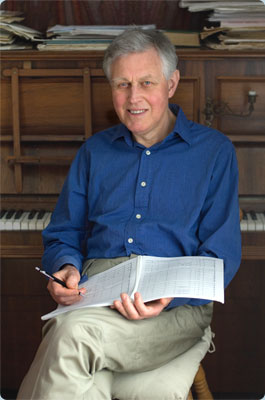
David Matthews. Photo © John Batten
|
Shortly after speaking with David, I found myself sitting next to John Hawkins, another regular Presteigne visitor, whose solo cello work Stranger, Lover, Dancer will be played on Sunday afternoon by Alice Neary. John studied with Malcolm Williamson and Elisabeth Lutyens, and was commissioned to write a Sea Symphony on a recommendation from Charles Mackerras. Another nautical work, Voices from the Sea, is available on CD, sung by Martyn Hill. This World, for choir and two trumpets, has been broadcast by the BBC Singers, and Urizen for viola and piano has been broadcast many times worldwide.
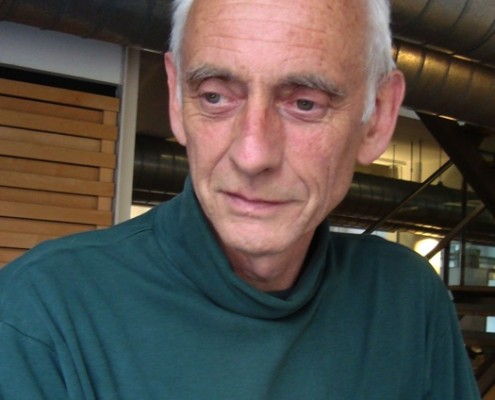
John Hawkins
|
The festival also features music by Richard Rodney Bennett, Richard Blackford, Benjamin Britten, Henri Duparc, George Dyson, Gabriel Fauré, Thomas Hyde, Cecilia McDowall, William Mathias, Olivier Messiaen, John Metcalf, Paul Patterson, Francis Poulenc, Deborah Pritchard, Maurice Ravel, Dmitri Shostakovich, Howard Skempton, Dobrinka Tabakova, Germaine Tailleferre, William Walton and Huw Watkins.
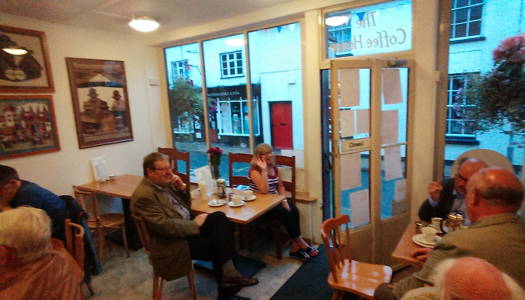
Conversation in The Coffee House, Presteigne, at the beginning of the 2016 Presteigne Festival. Photo © 2016 Keith Bramich
|
Next year's thirty-fifth anniversary festival, 24-29 August 2017, provides a chance to hear again some of the festival's successful previously commissioned works, gives an insight into Danish music and continues its relationship with Nova Music Opera for Joseph Phibbs' specially commissioned chamber opera Juliana. Further information about both the 2016 and 2017 festivals can be found online at presteignefestival.com
Copyright © 26 August 2016
Keith Bramich,
Worcestershire UK

|

